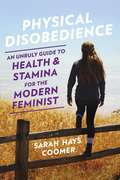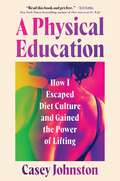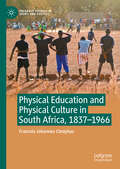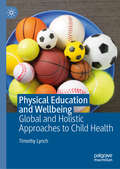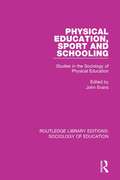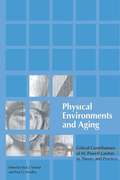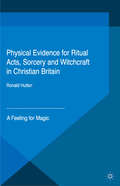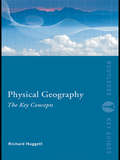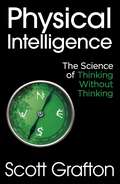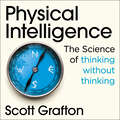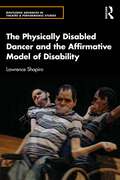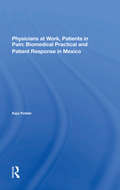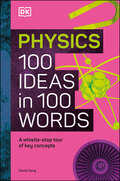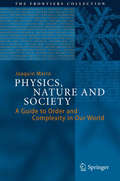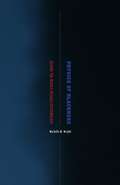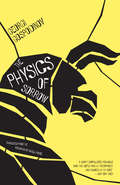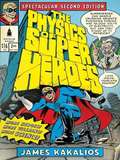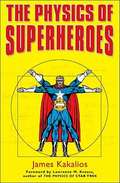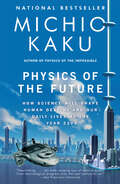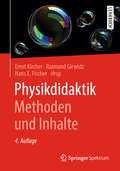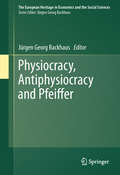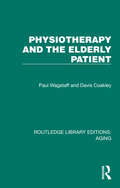- Table View
- List View
Physical Disability and Sexuality: Stories from South Africa
by Leslie Swartz Poul Rohleder Xanthe Hunt Stine Hellum Braathen Mussa Chiwaula Mark T. CarewThis open access edited volume explores physical disability and sexuality in South Africa, drawing on past studies, new research conducted by the editors, and first-person narratives from people with physical disabilities in the country. Sexuality has long been a site of oppression and discrimination for people with disabilities based on myths and misconceptions, and this book explores how these play out for people with physical disabilities in the South African setting. One myth with which the book is centrally concerned, is that people with disabilities are unable to have sex, or are seen as lacking sexuality by society at large. Societal understandings of masculinity, femininity, bodies and attractiveness, often lead people with physical disabilities to be seen as being undesirable romantic or sexual partners. The contributions in this volume explore how these prevailing social conditions impact on the access to sexual and reproductive healthcare, involvement in romantic relationships, childbearing, and sexual citizenship as a whole, of people with physical disabilities in the Western Cape of the country. The authors' research, and first person contributions by people with physical disabilities themselves, suggest that education and public health policy must change, if the sexual and reproductive health rights and full inclusion of people with disabilities are to be achieved.
Physical Disobedience: An Unruly Guide to Health and Stamina for the Modern Feminist
by Sarah Hays CoomerA manual for activism that begins with our most powerful asset--our bodiesEven as a wave of renewed feminism swells, too many women continue to starve, stuff, overwork, or neglect our bodies in pursuit of paper-thin ideals. "Fitness" has been co-opted by the beauty industry. We associate it with appearance when we should associate it with power. Grounded in advocacy with a rowdy, accessible spirit, Physical Disobedience asserts that denigrating our bodies is, in practice, an act of submission to inequality. But when we strengthen ourselves--taking broad command of our individual physicality--we reclaim our authority and build stamina for the literal work of activism: the protests, community service, and emotional resilience it takes to face the news and stay engaged. Physical Disobedience introduces a breathtaking new perspective on wellness by encouraging nonviolence toward our bodies, revitalizing them through diet and exercise, fashion and social media, alternative therapies, music, and motherhood. The goal is no longer to keep our bodies in check. The goal is to ignite them, to set them free, and have a mighty fine time doing it.
A Physical Education: How I Escaped Diet Culture and Gained the Power of Lifting
by Casey JohnstonFrom the most visible woman writing about weightlifting today, a "profoundly engrossing" memoir and manifesto about how lifting helped dissolve her allegiance to diet culture; taught her to be at home in her body; and led her to grow every kind of strength (Elizabeth Greenwood). In A Physical Education, Casey Johnston recounts how she ventured into the brave new world of weightlifting, leaving behind years of restrictive eating and endless cardio. Woven through the trajectory of how she rebuilt her strength and confidence is a staggering exposé of the damaging doctrine spread by diet and fitness culture. Johnston's story dives deep into her own past relationships with calorie restriction, exercise, and codependency. As she progresses on her weightlifting journey, she begins to eat to fuel her growing strength—and her food cravings vanish. Her physical progress fuels a growing understanding of how mainstream messaging she received about women&’s bodies was about preserving the status quo. Previously convinced that physical improvement was a matter of suffering, she now knows it requires self-regard and patience. A little pushing at a time adds up to the reawakening of parts of herself she didn&’t even know were there.A Physical Education asks why so many of us spend our lives trying to get "healthy&” by actively making our bodies weaker. Casey Johnston is a voice for those of us who feel underdeveloped and unfulfilled in our bodies and are looking to come home to ourselves.
Physical Education and Physical Culture in South Africa, 1837-1966 (Palgrave Studies in Sport and Politics)
by Francois Johannes CleophasThe interconnectedness between sport and colonialism has long been a matter of interest to sport historians. Consequently, a large number of scholarly works exist on physical education and physical culture history, but there is no significant work on this within a South African context, both nationally and at community level. This book therefore provides the first historical account of physical education and physical culture in Cape Town, South Africa and its surrounding areas in the Western Cape.
Physical Education and Wellbeing: Global and Holistic Approaches to Child Health
by Timothy LynchThis book explores how physical education (PE) can be best enacted in primary schools in order to optimise children’s wellbeing. Drawing together extensive data from school communities around the globe, the author examines multiple dimensions of child health in practice. Ultimately, the findings suggest that PE is imperative within the wider landscape of children’s holistic learning, offering a powerful platform for meaningful connections across learning areas. While quantitative research has long evidenced the benefits of physical activity, this book contributes to the complex and global issue of what effective health and wellbeing approaches look like in practice. It is natural for children to enjoy movement for the purposes of play, exploration, learning and development: this book is essential reading for educators looking to enhance children’s wellbeing and general health.
Physical Education, Sport and Schooling: Studies in the Sociology of Physical Education (Routledge Library Editions: Sociology of Education #20)
by John EvansIn Britain the physical education curriculum has been experiencing a period of unrest. For many teachers the practices of decades have become problematic features of their curriculum and teaching. This book, first published in 1986, explores the experiences of teachers and pupils in programmes of physical education from a sociological perspective. In explores a range of issues relating to the organisation and management of physical education departments, deviancy and dissent in sport, gender inequalities and the concepts of community education and leisure education. This title will be of interest to students of sociology and education.
Physical Environments and Aging: Critical Contributions of M. Powell Lawton to Theory and Practice
by Paul Windley Rick ScheidtA tribute and guide to M. Powell Lawton's groundbreaking work! Dr. M. Powell Lawton, who died in January 2001, was arguably the most significant thinker, researcher, and practitioner in environment-behavior studies within the field of gerontology. The authors of Physical Environments and Aging represent three generations of internationally recognized researchers whose lives and work were greatly influenced by both Lawton the professional and Lawton the man. This book presents their assessment of his contributions to environmental theory, purpose-built housing, community study, long-term care settings, and other related topics. Many of the contributors also share personal anecdotes that illustrate how Lawton's professional visions were shaped by his remarkable intellect and personality. Physical Environments and Aging examines many aspects of environmental gerontology, including: housing policy reform and home modification place therapy philosophic foundations of environment-aging studies the future of theory, practice, and policy in the field the role of neighborhoods More than just an homage, Physical Environments and Aging is also a practical guide to the field, offering you tractable theory, useful methods and measures, and functional research overviews in the realms of everyday experience of older adults.
Physical Evidence for Ritual Acts, Sorcery and Witchcraft in Christian Britain: A Feeling for Magic (Palgrave Historical Studies in Witchcraft and Magic)
by Ronald HuttonThis volume investigates the physical evidence for magic in medieval and modern Britain, including ritual mark, concealed objects, amulets, and magical equipment. The contributors are the current experts in each area of the subject, and show between them how ample the evidence is and how important it is for an understanding of history.
Physical Geography: The Key Concepts (Routledge Key Guides)
by Richard John HuggettPhysical Geography: The Key Concepts is a thought-provoking and up-to-date introduction to the central ideas and debates within the field. It provides extended definitions of terms that are fundamental to physical geography and its many branches, covering topics such as: biogeography ecology climatology meteorology geomorphology hydrology pedology Complete with informative tables, diagrams, and suggestions for further reading, this is a highly accessible guide for those studying physical geography and related courses.
Physical Intelligence: The Science of Thinking Without Thinking
by Scott Grafton'An instant classic' Michael S. Gazzaniga, author of The Consciousness InstinctHow do you pick the right moment to cross a busy road?Or decide if you can drive through a storm? What helps you discover a shortcut to a familiar route?The answer is PHYSICAL INTELLIGENCE.Renowned neuroscientist, doctor and keen climber Scott Grafton draws on the very latest research, experiences with patients and his own dangerous hikes in the wilderness to explore the hidden depths of this silent intellect we all possess.Physical Intelligence explains the science behind our oldest ability and takes a fascinating and vital look at how we could and should use it better.
Physical Intelligence: The Science of Thinking Without Thinking
by Scott GraftonWhat is it that stops us from walking into walls or off cliffs? How do you pick the right moment to cross a busy road Or decide if you can drive through a storm? What helps you discover a shortcut to a familiar route?The answer is PHYSICAL INTELLIGENCESometimes, you need to do it to know it. Your hands have to be on the steering wheel to learn the feel of slipping tyres. You need to be watching the traffic to judge the best moment to cross the road. Everything we do, from changing a lightbulb to navigating unknown terrain relies on physical intelligence, our oldest and most important form of cognition. Physical intelligence was the key development in human evolution; thinking evolved first and foremost so we could do things. It has been the key to our survival against all the odds for so long that it has become instinctive, and continues to underpin our every action, from the ordinary (walking down a street) to the extraordinary (winning a race) and beyond. Renowned neuroscientist, doctor and keen climber, Scott Grafton was fascinated to discover how physical intelligence's most important components were laid bare, away from civilisation. In this book he takes you on a journey to explore the hidden depths of this silent, ruthless intellect we all possess. Drawing on the latest scientific discoveries and research, experiences with patients, and Professor Grafton's own gripping stories of survival in the wilderness, Physical Intelligence explains the science behind our most overlooked ability and takes a fascinating and vital look at how we could and should use it better. (P)2020 Hodder & Stoughton Limited
Physical Security and Environmental Protection
by John PerdikarisManage a Hazard or Threat Effectively and Prevent It from Becoming a DisasterWhen disaster strikes, it can present challenges to those caught off guard, leaving them to cope with the fallout. Adopting a risk management approach to addressing threats, vulnerability, and risk assessments is critical to those on the frontline. Developed with first res
The Physically Disabled Dancer and the Affirmative Model of Disability (Routledge Advances in Theatre & Performance Studies)
by Lawrence ShapiroThis volume investigates the contributions and achievements of the physically disabled dancer while challenging and recognizing the inherent inequities in the field of integrated dance in the UK which currently places greater emphasis on the learning‑disabled performer. This is the first book ever written by a physically disabled dancer on the subject of physically disabled dancers. Inherent in this examination is the model of examining disability that is most closely associated with the disability arts movement which is the ‘affirmative model of disability’. This model is defined as an approach to disability in which the disabled person is neither an object of medical care nor a victim of social indifference but a self‑respecting, autonomous individual in which their disability is a positive and affirming aspect of their self‑identity. This book, based on interviews with physically disabled dancers, choreographers, academics and arts producers all in a UK context, combines a wide range of perspective of disability dance together with the intellectual rigour of disability studies to produce a new definition of the physically disabled dancer as an affirming, positive, indispensable practitioner of contemporary performance art. The volume pioneers perspectives of the physically disabled dancer prioritizing first‑person accounts from the performers themselves to produce an unprecedented contribution to the study of disability arts from a uniquely British perspective.This book will offer educators as well as arts and cultural professionals a critical resource for facilitating work by and in alliance with practitioners of integrated dance.
Physician-Assisted Death in Perspective
by Stuart J. Youngner Gerrit K. KimsmaThis book is the first comprehensive report and analysis of the Dutch euthanasia experience over the last three decades. In contrast to most books about euthanasia, which are written by authors from countries where the practice is illegal and therefore practised only secretly, this book analyzes empirical data and real-life clinical behavior. Its essays were written by the leading Dutch scholars and clinicians who shaped euthanasia policy and who have studied, evaluated and helped regulate it. Some of them have themselves practised euthanasia. The book will contribute to the world literature on physician-assisted death by providing a comprehensive examination of how euthanasia has been practised and how it has evolved in one specific national and cultural context. It will greatly advance the understanding of euthanasia among both advocates and opponents of the practice.
Physicians At Work, Patients In Pain: Biomedical Practice And Patient Response In Mexico
by Kaja FinklerThis ethnographic study offers a detailed picture of how modern biomedicine is altered when practised in a developing country. Addressing the question of therapeutic outcome, Dr Finkler examines various aspects of biomedicine that influence patient response. The doctor-patient relationship is seen as especially important. Physicians and patients sp
Physics 100 Ideas in 100 Words: A Whistle-stop Tour of Science's Key Concepts
by DKGet to grips with the essential topics in physics today through 100 key ideas, each one explained clearly in 100 words.Physics: 100 Ideas in 100 Words offers the essential facts at your fingertips, satisfying your scientific curiosity and helping you to understand the biggest concepts in physics in concise, 100-word summaries. One of the first titles in a cutting-edge new series created in partnership with The Science Museum, this book introduces 100 key areas of physics such as gravity, motion, magnetism and quantum physics, and explains each topic in just 100 words. Perfect for getting your head around big ideas clearly and quickly, or refreshing your memory of the fundamentals of physics, this book covers the most up-to-date terms and theories and inspires a heightened level of understanding and enjoyment to the core areas of physics.
Physics, Nature and Society
by Joaquín MarroThis wide-ranging and accessible book serves as a fascinating guide to the strategies and concepts that help us understand the boundaries between physics, on the one hand, and sociology, economics, and biology on the other. From cooperation and criticality to flock dynamics and fractals, the author addresses many of the topics belonging to the broad theme of complexity. He chooses excellent examples (requiring no prior mathematical knowledge) to illuminate these ideas and their implications. The lively style and clear description of the relevant models will appeal both to novices and those with an existing knowledge of the field.
Physics of Blackness: Beyond the Middle Passage Epistemology
by Michelle M. WrightWhat does it mean to be Black? If Blackness is not biological in origin but socially and discursively constructed, does the meaning of Blackness change over time and space? In Physics of Blackness: Beyond the Middle Passage Epistemology, Michelle M. Wright argues that although we often explicitly define Blackness as a &“what,&” it in fact always operates as a &“when&” and a &“where.&” By putting lay discourses on spacetime from physics into conversation with works on identity from the African Diaspora, Physics of Blackness explores how Middle Passage epistemology subverts racist assumptions about Blackness, yet its linear structure inhibits the kind of inclusive epistemology of Blackness needed in the twenty-first century. Wright then engages with bodies frequently excluded from contemporary mainstream consideration: Black feminists, Black queers, recent Black African immigrants to the West, and Blacks whose histories may weave in and out of the Middle Passage epistemology but do not cohere to it. Physics of Blackness takes the reader on a journey both known and unfamiliar—from Isaac Newton&’s laws of motion and gravity to the contemporary politics of diasporic Blackness in the academy, from James Baldwin&’s postwar trope of the Eiffel Tower as the site for diasporic encounters to theoretical particle physics&’ theory of multiverses and superpositioning, to the almost erased lives of Black African women during World War II. Accessible in its style, global in its perspective, and rigorous in its logic, Physics of Blackness will change the way you look at Blackness.
The Physics of Sorrow
by Angela Rodel Georgi Gospodinov"Georgi Gospodinov wants to blow your mind--or maybe just provide the ultimate bathroom reader. . . . The formal playfulness suggests Kundera with A.D.D. and potty jokes."--Ed Park, The Village VoiceA finalist for both the Strega Europeo and Gregor von Rezzori awards (and winner of every Bulgarian honor possible), The Physics of Sorrow reaffirms Georgi Gospodinov's place as one of Europe's most inventive and daring writers.Using the myth of the Minotaur as its organizing image, the narrator of Gospodinov's long-awaited novel constructs a labyrinth of stories about his family, jumping from era to era and viewpoint to viewpoint, exploring the mindset and trappings of Eastern Europeans. Incredibly moving--such as with the story of his grandfather accidentally being left behind at a mill--and extraordinarily funny--see the section on the awfulness of the question "how are you?"--Physics is a book that you can inhabit, tracing connections, following the narrator down various "side passages," getting pleasantly lost in the various stories and empathizing with the sorrowful, misunderstood Minotaur at the center of it all.The Physics of Sorrow will appeal to fans of Dave Eggers, Tom McCarthy, and Dubravka Ugresic for its unique structure, humanitarian concerns, and stunning storytelling.Georgi Gospodinov's Natural Novel was published by Dalkey Archive Press in 2005 and was praised by the New Yorker, New York Times, and several other prestigious review outlets.Angela Rodel won a PEN Translation Fund Grant in 2010 for Georgi Tenev's short story collection. She is one of the most prolific translators of Bulgarian literature working today and received an NEA Fellowship for her translation of Gospodinov's The Physics of Sorrow.
The Physics of Superheroes: Spectacular Second Edition
by James KakaliosA complete update to the hit book on the real physics at work in comic books, featuring more heroes, more villains, and more science Since 2001, James Kakalios has taught "Everything I Needed to Know About Physics I Learned from Reading Comic Books," a hugely popular university course that generated coast-to-coast media attention for its unique method of explaining complex physics concepts through comics. With The Physics of Superheroes, named one of the best science books of 2005 by Discover, he introduced his colorful approach to an even wider audience. Now Kakalios presents a totally updated, expanded edition that features even more superheroes and findings from the cutting edge of science. With three new chapters and completely revised throughout with a splashy, redesigned package, the book that explains why Spider-Man's webbing failed his girlfriend, the probable cause of Krypton's explosion, and the Newtonian physics at work in Gotham City is electrifying from cover to cover.
The Physics of Superheroes
by James KakaliosA complete update to the hit book on the real physics at work in comic books, featuring more heroes, more villains, and more science Since 2001, James Kakalios has taught "Everything I Needed to Know About Physics I Learned from Reading Comic Books," a hugely popular university course that generated coast-to-coast media attention for its unique method of explaining complex physics concepts through comics. With The Physics of Superheroes, named one of the best science books of 2005 by Discover, he introduced his colorful approach to an even wider audience. Now Kakalios presents a totally updated, expanded edition that features even more superheroes and findings from the cutting edge of science. With three new chapters and completely revised throughout with a splashy, redesigned package, the book that explains why Spider-Man's webbing failed his girlfriend, the probable cause of Krypton's explosion, and the Newtonian physics at work in Gotham City is electrifying from cover to cover. .
Physics of the Future: How Science Will Shape Human Destiny and Our Daily Lives by the Year 2100
by Michio KakuNATIONAL BESTSELLER • The renowned theoretical physicist and national bestselling author of The God Equation details the developments in computer technology, artificial intelligence, medicine, space travel, and more, that are poised to happen over the next century. &“Mind-bending…. [An] alternately fascinating and frightening book.&” —San Francisco ChronicleSpace elevators. Internet-enabled contact lenses. Cars that fly by floating on magnetic fields. This is the stuff of science fiction—it&’s also daily life in the year 2100.Renowned theoretical physicist Michio Kaku considers how these inventions will affect the world economy, addressing the key questions: Who will have jobs? Which nations will prosper? Kaku interviews three hundred of the world&’s top scientists—working in their labs on astonishing prototypes. He also takes into account the rigorous scientific principles that regulate how quickly, how safely, and how far technologies can advance. In Physics of the Future, Kaku forecasts a century of earthshaking advances in technology that could make even the last centuries&’ leaps and bounds seem insignificant.
Physikdidaktik | Methoden und Inhalte
by Ernst Kircher Raimund Girwidz Hans E. FischerDas vorliegende Buch bietet den Leserinnen und Lesern einen fundierten Überblick über die Methoden der Physikdidaktik und bietet eine Hilfestellung, hochspannende Themen in den Physikunterricht einzubinden. In Einzelbeiträgen diskutieren Autorinnen und Autoren Methoden und Inhalte der Physikdidaktik – angefangen von der qualitativen Forschung in der Fachdidaktik über Aus- und Fortbildungen von Physiklehrerinnen und -lehrern zur Professionskompetenz und Nature of Science. Daran anschließend werden aktuelle und forschungsnahe Themengebiete und ihre mögliche Einbindung in den Unterricht dargestellt: Bio-, Quanten-, Nano- und Elementarteilchenphysik, Astronomie, Chaos, Physik des Klimawandels und die Physik der Gravitationswellen. Das Standardwerk Physikdidaktik wird in der Neuauflage thematisch getrennt angeboten: Grundlagen und Methoden und Inhalte. Beide Bände richten sich an Studierende des Lehramts Physik, angehende Lehrkräfte im Vorbereitungsdienst und Physiklehrerinnen und -lehrer.
Physiocracy, Antiphysiocracy and Pfeiffer
by Jürgen BackhausPhysiocracy, or the economic theory that a nation's wealth comes from is agricultural and land development, was a popular school of thought in France in the 18th century. The contribution and significance of the Physiocrats and Antiphysiocrats are explored in detail through chapter contributions by economists, philosophers, and social historians. The book concludes that neither the Physiocrats, nor the Antiphysiocrats were pure profit maximizers and that they all had the well-being of the commonwealth in mind. It brings to light previous studies only conducted in German and is the first analysis of Pfeiffer in a century, making the book of interest to any student or scholar of political economy and the history of economic thought. The contribution and significance of the Physiocrats and Antiphysiocrats are explored in detail through chapter contributions by economists, philosophers, and social historians. It brings to light previous studies only conducted in German and is the first analysis of Pfeiffer in a century, making the book of interest to any student or scholar of political economy and the history of economic thought.
Physiotherapy and the Elderly Patient (Routledge Library Editions: Aging)
by Paul Wagstaff Davis CoakleyOriginally published in 1988, the purpose of this book was to introduce the student and practicing physiotherapist to the multi-faceted components of the care and treatment of elderly patients and to present a problem-orientated approach to physiotherapy, assessment and management. Care of the elderly demands a dynamic and responsible approach and it was hoped that this book would improve therapy skills. The authors’ principle aim was to describe appropriate physiotherapy practice together with the pathology and medicine of old age. There is also consideration of social and psychological issues and working with the elderly people in the community as well as in hospital.

